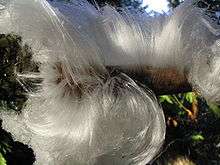Hair ice

Hair ice (also known as ice wool or frost beard) is a type of ice that forms on dead wood and takes the shape of fine, silky hair.[1] It is somewhat uncommon, and has been reported mostly at latitudes between 45 and 55°N in broadleaf forests.[1][2] The meteorologist and discoverer of continental drift, Alfred Wegener, described hair ice on wet dead wood in 1918,[3] assuming some specific fungi as the catalyst, a theory mostly confirmed by Gerhart Wagner and Christian Mätzler in 2005.[4][5][6] In 2015, the fungus Exidiopsis effusa was identified as key to the formation of hair ice.[1]
Formation
.jpg)
Hair ice forms on moist, rotting wood from broadleaf trees when temperatures are slightly under 0 °C (32 °F) and the air is humid.[1] Each of the smooth, silky hairs has a diameter of about 0.02 mm and a length of up to 20 centimetres (7.9 in).[1] The hairs are brittle, but take the shape of curls and waves.[1] They can maintain their shape for hours and sometimes days.[1] This long lifetime indicates that something is preventing the small ice crystals from recrystallizing into larger ones, since recrystallization normally occurs very quickly at temperatures near 0 °C.[1]
The hairs appear to root at the mouth of wood rays (never on the bark), and their thickness is similar to the diameter of the wood ray channels.[1] A piece of wood that produces hair ice once may continue to produce it over several years.[1]
In 2015, German and Swiss scientists identified the fungus Exidiopsis effusa as key to the formation of hair ice.[1] The fungus was found on every hair ice sample examined by the researchers, and disabling the fungus with fungicide or hot water prevented hair ice formation.[1] The fungus shapes the ice into fine hairs through an uncertain mechanism and likely stabilizes it by providing a recrystallization inhibitor similar to antifreeze proteins.[1][2]
See also
References
- 1 2 3 4 5 6 7 8 9 10 11 12 13 Hofmann D, Preuss G, Mätzler C (2015). "Evidence for biological shaping of hair ice." (PDF). Biogeosciences. 12: 4261–4273. doi:10.5194/bg-12-4261-2015.
- 1 2 European Geosciences Union (22 July 2015). "Press Release: Fungus shapes hair ice – Researchers identify fungus responsible for peculiar ice filaments that grow on dead wood". Retrieved 24 July 2015.
- ↑ Alfred Wegener: Haareis auf morschem Holz. Die Naturwissenschaften 6/1, 1918. S. 598–601.
- ↑ Gerhart Wagner: Haareis – eine seltene winterliche Naturerscheinung. Was haben Pilze damit zu tun? SZP/BSM 2005.
- ↑ Gerhart Wagner, Christian Mätzler: Haareis auf morschem Laubholz als biophysikalisches Phänomen. Forschungsbericht Nr. 2008-05-MW. Universität Bern. 2008. (PDF-Download)
- ↑ Gerhart Wagner, Christian Mätzler: Haareis - Ein seltenes biophysikalisches Phänomen im Winter. Naturwissenschaftliche Rundschau 62(3), S. 117–123 (2009), ISSN 0028-1050
External links
| Wikimedia Commons has media related to Hair ice. |